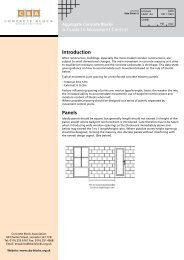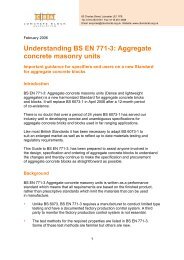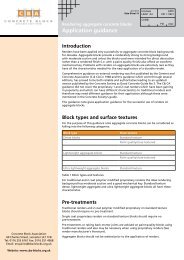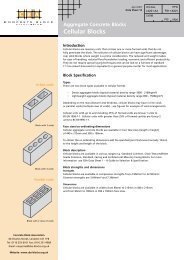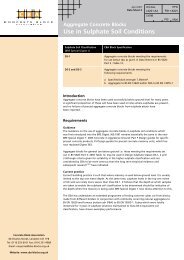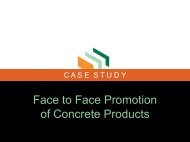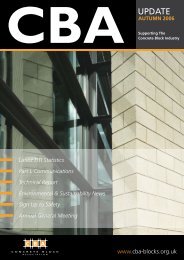Introduction Life Cycle Principles Embodied carbon - Concrete Block ...
Introduction Life Cycle Principles Embodied carbon - Concrete Block ...
Introduction Life Cycle Principles Embodied carbon - Concrete Block ...
You also want an ePaper? Increase the reach of your titles
YUMPU automatically turns print PDFs into web optimized ePapers that Google loves.
In-Use performance:<br />
• External and separating/party wall thermal insulation solutions are available that<br />
contribute significantly to meeting Building Regulations thermal requirements and<br />
the future development of zero <strong>carbon</strong> construction 4 .<br />
• External cavity walls can be built with aggregate concrete blocks to U-values of 0.18<br />
using conventional designs and cavities of between 100mm and 150mm depending<br />
on the type of insulation specified. Lower U-values can be achieved by either raising<br />
the quality of insulation and/or its thickness.<br />
• Thermal mass effects provide more efficient long term energy/<strong>carbon</strong> performance<br />
than lighter weight construction 5 .<br />
• Aggregate blocks are durable, fire resistant, not attacked by vermin or insects, do not<br />
introduce harmful substances into the internal environment of buildings and require<br />
minimal maintenance over the full life of the building. <strong>Block</strong> construction is resistant<br />
to flooding, a potentially increasing risk in the UK due to climate change.<br />
• The BRE Green Guide to Construction provides environmental performance ratings<br />
for typical UK constructions on the basis of A+ to E ratings. Many aggregate block<br />
constructions are at the higher performing A and A+ ratings 6 .<br />
• The Code for Sustainable Homes 7 and the BRE Environmental Assessment Method<br />
(BREEAM) 8 are currently the most commonly used sustainability assessment methods<br />
in the UK. Aggregate block construction attracts high levels of credits for:<br />
– Thermal performance (within Energy and Carbon).<br />
– Acoustic performance (within Health and Wellbeing).<br />
– Environmental performance ( due to high Green Guide ratings).<br />
– Responsible sourcing of materials (through ISO 14001 and BES 6001 certification).<br />
End of <strong>Life</strong>:<br />
• Buildings constructed with aggregate concrete blocks can be easily modified to<br />
extend their life and to accommodate the developing needs of occupiers or for a<br />
change of use.<br />
• <strong>Block</strong>s are fully recyclable e.g. as a source of aggregate for future construction.<br />
References/Links<br />
1. BS EN 15804:2012 “Sustainability of construction works. Environmental product<br />
declarations. Core rules for the product category of construction products”<br />
2. British Precast Sustainability Charter. Independently audited annual returns<br />
representative of 60% plus of UK manufactures aggregate concrete blocks<br />
http://www.britishprecast.org<br />
3. BRE BES 6001 “Framework standard for the Responsible sourcing of construction<br />
products”<br />
http://www.greenbooklive.com/search/scheme.jsp?id=153<br />
4. CBA data sheets ‘External insulation of solid walls’ and ‘External walls thermal<br />
performance’.<br />
www.cba-blocks.org.uk<br />
5. “A whole life CO2 argument for concrete blocks” Tom de Saulles CBA Spring 2012<br />
Newsletter<br />
www.cba-blocks.org.uk<br />
6. BRE Green Guide to Construction<br />
http://www.bre.co.uk/greenguide/podpage.jsp?id=2126<br />
7. Code for Sustainable Homes<br />
http://www.planningportal.gov.uk/buildingregulations/greenerbuildings/<br />
sustainablehomes/<br />
8. BRE Environmental Assessment Method<br />
http://www.breeam.org/<br />
9. Bath University Inventory of Energy and Carbon<br />
http://www.bath.ac.uk/mech-eng/sert/embodied/




